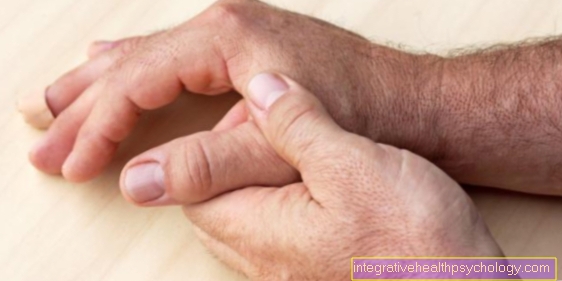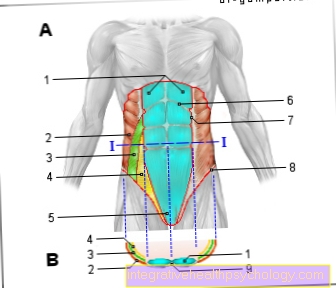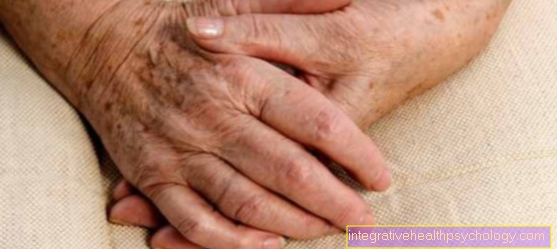Folliculitis
introduction
Folliculitis describes an inflammation of the hair follicles, which are also known as the hair follicle. It can be both acute and chronic.
Folliculitis can also be non-purulent or be accompanied by the formation of pus. Folliculitis is often triggered by bacterial, fungal, or parasite infections.
Folliculitis can also be caused by immunodeficiency or medication. Hairy areas of the body such as the head or buttocks are particularly predisposed to folliculitis. Folliculitis is aggravated in particular by increased sweating in these regions.
Find out more about the topic: Hair follicle

causes
Folliculitis has a number of different causes. These causes can be roughly divided into infectious and non-infectious causes.
These two large groups can in turn be divided into several subgroups. Bacteria come first among the infectious causes of folliculitis. The bacterium Staphylococcus aureus in particular plays a decisive role here. This bacterium is typically found as part of the normal skin flora. If the skin is injured or there is an immune deficiency, this can lead to inflammation of the hair follicle.
Another possible infectious cause of folliculitis is a colonization with fungi, the so-called dermatophytes.
Viruses such as the herpes simplex virus can also be a cause of folliculitis.
Parasites, especially certain types of mites, can also cause infectious folliculitis.
For example, non-infectious folliculitis can be caused by numerous drugs. These include steroids and so-called thyrosine kinase inhibitors, which can be used in cancer therapy.
Hair growth disorders or disorders of the skin cornification can also be the cause of folliculitis.
A congenital immunodeficiency or an immunodeficiency caused by the use of immunosuppressive drugs can equally be the cause of the development of folliculitis. In addition, chronic diseases such as diabetes mellitus can cause folliculitis. For some forms of folliculitis, the cause is not yet known.
Symptoms
As with all inflammations, folliculitis also has the classic symptoms of inflammation.
These inflammation symptoms present themselves as redness, swelling and overheating of the affected area. Folliculitis can also be very painful. In some cases, the inflamed hair follicles become uncomfortable itching.
The affected patient may see small papules or pustules in the inflamed area. These often present in the middle of the pustule with a single hair, which is very typical for this disease, since the hair follicle is ultimately affected in folliculitis.
Typical areas for the occurrence of folliculitis are hairy areas of the body such as the head, beard and also the buttocks. Typical symptoms of folliculitis often arise when the affected area has been previously shaved. The smallest skin lesions give pathogens the chance to penetrate the skin and cause inflammation. Some forms of folliculitis don't just lead to inflammation of the hair follicles.
As part of the so-called Folliculitis declavans There is initially an inflammation, in the course of a crust formation and finally a scarred healing, which causes hairless areas. Scales can also form in the inflamed area if the skin becomes infected. These scales occur mainly on the edge of the inflamed areas.
Folliculitis is the preliminary stage of a boil. The terms "abscess" and "furuncle" are often used as synonyms. But there are some clear distinguishing features. Read our article on this: Abscess or boil
diagnosis
The diagnosis one Folliculitis is typically a visual diagnosis for the doctor. Small, inflamed areas of skin with centrally growing hair and possibly visible pus appear to the doctor.
If the diagnosis is not that obvious and easy to make, or if folliculitis keeps recurring, then it should Systemic diseases such as diabetes mellitus or an immunodeficiency as a cause of folliculitis must be excluded. Sometimes it is difficult to make a diagnosis because the folliculitis does not necessarily present itself with the classic symptoms, but also shows a few other symptoms such as scarred healing. In some cases, a Sample biopsy the affected area make sense. A small area of skin is removed and finally examined histologically.
Folliculitis capitis
Also at the Scalp can a Folliculitis occur. This is then medically called Folliculitis capitis designated. A folliculitis capitis is also called Pyoderma fistulans significa or as atrophic disease with tufted hair described.
She is in Contrasted with general folliculitis a comparatively rare disease. Folliculitis of the scalp occurs almost exclusively Men in front. A hallmark of folliculitis of the scalp is the formation of ducts in the course of inflammation of the hair follicles. Such courses are also called Fistulas designated.
An increased incidence of inflammation of the hair follicle is within Acne diseases observed. It could therefore be a Associated with increased sebum production exist, which could be a triggering factor.
Folliculitis of the scalp also goes with the Formation of small pustules and Papules along with that usually painless are. Typical of this disease are the small ducts below the scalp that form during the course of the disease and connect the individual inflamed foci with one another. Unfortunately, the healing takes place under the Formation of scars, from which the name atrophic disease is derived. The scars form bridges between the individual foci of inflammation, often in the course of the fistula ducts. In these places the hair follicles perish and form hairless spots. It is important to differentiate folliculitis capitis from folliculitis declavans, as it represents a different clinical picture.
Folliculitis declavans
The Folliculitis declavans is also a rather rare disease and goes with you chronic course hand in hand.
As with folliculitis capitis, folliculitis declavans also develop scar which lead to so-called alopecia. Means alopecia Hair loss. The disease often occurs only in Adulthood on and usually only affects men.
The cause of folliculitis declavans has not been fully understood. It has been linked to an infection with the bacterium Staphylococcus aureus. More possible causes put a genetic inheritance or one immunodeficiency Unfortunately, more detailed information about the development of folliculitis declavans is not known.
At the beginning of the disease, small bumps form around the hair follicles, which eventually become inflamed as the disease progresses. Folliculitis declavans also heals under a central scar and progresses in other places. The plate-like scar formation goes here with one irreversible hair loss and the disease usually takes a chronic course. The appearance of folliculitis declavans is often not easy to distinguish from folliculitis capitits.
Cure a folliculitis
Folliculitis can heal spontaneously in some forms. If folliculitis developed during a shave, it usually heals on its own.
In a simple form of folliculitis due to infection with staphylococcus aureus, the skin heals completely. This results in neither secondary diseases nor scars.
However, relapses occur more frequently in the context of autoimmune diseases or other systemic diseases.
Some forms also require therapy to heal. In both folliculitis capitis and folliculitis declavans, there is no complete healing. These two forms of folliculitis are chronic rather than acute, so that in most cases there is no complete cure. The special thing about these two forms of folliculitis is that scars form in the healing process of the affected areas and there remains a lifelong hairlessness.
Therapy for folliculitis
The therapy for folliculitis differs depending on the type and cause of the hair follicle inflammation.In most cases, drug therapy is carried out, which, depending on the type and extent, can be administered systemically, for example in the form of tablets, or locally.
If folliculitis developed as part of a fungal skin infection, i.e. what is known as tinea capitis, then the therapy consists of an antifungal treatment. This is often locally limited and usually takes the form of an ointment.
If these measures do not heal folliculitis, systemic therapy in the form of tablets can also be tried. If folliculitis develops, for example when shaving the beard, a disinfectant solution based on an alcoholic solution often helps. In very pronounced cases, short-term antibiotics can also be helpful.
There is also the option of applying an antibiotic ointment locally to the affected areas.
In the case of folliculitis capitis, the therapy looks a little different from that of simple folliculitis. A combination treatment consisting of glucocorticoids and so-called retinoids is used here. Retinoids are often used in the treatment of severe acne. Folliculitis capitis is usually associated with existing acne, so treatment with retinoids makes sense. Tinctures with glucocorticoids or salicylic acid are also used. In some cases, antibiotics can also be used here.
Folliculitis declavans should also be treated. Above all, disinfecting solutions with an antimicrobial effect are used, which are applied to the affected areas from the outside. Retinoids and antibiotics are also part of the therapy for folliculitis declavans. In the case of severe inflammation, a short-term administration of glucocorticoids for immunosuppression can be considered.
If folliculitis occurs as a result of cornification and growth disorders, there is a large number of local ointments available that can be used for this. These include antiseptic ointments and ointments such as tacrolimus, which belong to the class of immunosuppressants.
Finally, as an important pillar of the treatment of folliculitis, it is essential to think about adequate personal hygiene. It is important to ensure that moist skin areas should be kept as dry as possible.





























